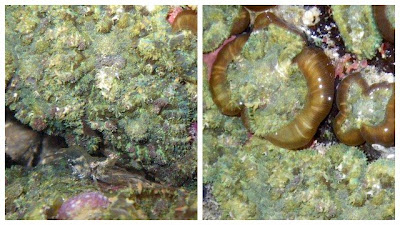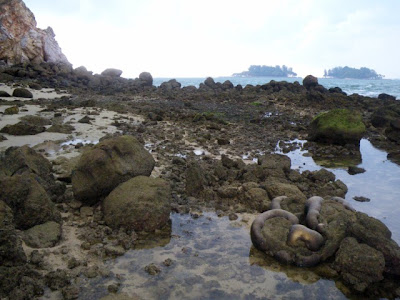St John's Island is one of the few southern islands with natural coastlines that the public can still access.
During a low spring tide, the pink outcrops and cliffs extends all the way to the sea as a rocky shore. And among the rocks are marine life that peeks out of water during the short few hours of low tide. These include the large boulder-like corals.
Beyond the shore, one can also see the twin island, Sisters Island.
There are both hard and soft corals on the reefs of St John's Island. And they can be really humongous! I wonder how old are these corals.
In the water, the soft corals extend out their living polyps creating this furry look.
As for hard corals, they look greenish or brownish because they harbour living algae (aka zooxanthallae) within themselves which makes food for the corals.
Some of the greenish coloration from the zooxanthallae can be bright in colour, looking really pretty in this Pore coral (Porites sp.). However, if the corals are stressed, coral bleaching will occur when the algae are expelled out of the corals.
Some corals can also look rather interesting like a maze just like this coral from the Genus Platygyra.
The Blue corals (Heliopora coerulea) are sometimes rather confusing. Firstly, they are often brown and don't appear blue at all. Secondly, although they have a hard skeleton, they are not grouped with other hard corals. :P
Somehow, I happen to find this boulder-like coral with an extensive growth of sponge on top of it.
And this one has lots of the Oval sea grapes seaweed (Caulerpa racemosa) on top of the coral. I don't if there is any special meaning in life growing on top of living corals.
During the trip, I was surprised to find many blue patches similar to that of Kusu Island.

These blue clumps are actually blue feathery soft corals. They have eight tentacles in each polyps, which is a distinguishing factor from hard corals with six of multiples of six tentacles in each polyp.

Also blueish green in colour, this colony is neither a coral nor an anemone. They are Corallimorph (Order Corallimorpharia), which still is related to corals and anemones as they all fall into the Class Anthozoa.
Similar to corals, most corallimorphs harbour zooxanthellae (symbiotic algae) inside their bodies. The symbiotic algae carry out photosynthesis and may contribute nutrients to the host.
Beneath rocks, I chanced upon this encrusting organism which I have seen before elsewhere but I don't know what exactly it is.
More clumps of life among rocks include the Button zoanthids (Zoanthus sp.).
Like corallimorphs, zoanthids belong to the same Class Anthozoa. They look like colonial anemones though they are not true anemones. While sea anemones are solitary polyps, most zoanthids live in colonies like corals do. But zoanthids don't produce a hard skeleton like the hard coral colonies. Instead, their skin is leathery and composed partly of chitin.
More colourful encrusting organisms include sponges.
Sponges come in a wide variety of colours and shape. This is a barrel sponge that looks like a barrel. Probably when I mention sponges, you might just remember the all-time favourite cartoon character: sponge bob square pants. Let you imagination run wild with this yellow sponge by adding eyes, mouth and limbs in your mind. :-)
I didn't many crabs on the reef this time except for this Brown egg crab (Atergatis floridus). As I have probably said many times in the blog, this crab is no joke as it is poisonous and should not be eaten.
Sadly, for this echinoderm lover, there are not many echinoderms on the reefs of St John's. But it's still a consolation to find several of these long black sea cucumber (Holothuria leucospilota) beside the base of many rocks.
I have started to learn the "secrets" of finding more life in a rocky shore. And that is to flip rocks since many creatures hide beneath rocks to shelter themselves from heat and dessication when the tide retreats.
And to my delight, I saw this really cute little brittlestar that positioned itself so snudgely on this bright orange sponge.

More life beneath rocks include a living clam and also the Wandering cowrie (Cypraea errones).
It is fun and enjoyable to appreciate marine life underneath rocks, but please remember to put the rocks back into their original orientation and position after looking. Otherwise these poor creatures will be stressed out when they are now exposed to the environment facing upwards.
There were a couple of wormy finds and this one is particularly super long. This is the Ribbon worm (Phylum Nemertea).
Despite looking softy and harmless, ribbon worms are fierce predators. They have a unique eversible proboscis that can wound around the prey which is then hauled back toward the worm's mouth. After which, sticky mucus is secreted to help grip the prey. Siyang has photos of the ribbon worms tackling a prawn! Check it out here in his Urban Forest blog.
The next wormy find is this gorgeous flatworm called the Blue-lined flatworm (Pseudoceros sp.).
I love flatworms and nudibranchs because of the wide variety of colours and patterns that different species have.
Yes there are nudis at St John's reef like this ever-cute Polka-dot nudibranch (Jorunna funebris).
This bluish blob animal is an example of another nudibranch that look distinctly different from other species. This is the Pimply phyllid nudibranch (Phyllidiella pustulosa).
But the most special find of the day must be this stunning bright orange coloured Rose nudibranch (Dendrodoris fumata). I was just telling James to try and flip rocks to find creatures and the first rock I flipped to show him, we found a couple of this special nudi! It's truly magical.
St John's reef seem to be affected from the recent cliff repair and the presence of the land bridge connecting Lazarus and St John's which might have affected the hydrodynamics of the sea water. I hear lots of stories of how better the reef was in the past.
This field trip has shown that the reef is still alive and that we mustn't give up on it! Even the moult of a Mud Spiny Lobster (Panulirus polyphagus) was found on the next day during a guided walk on the same reef!
Let's hope the natural reefs of St John's will continue to exist in a healthy state for future generations to enjoy.
Monday, July 13, 2009
Natural reefs of St John's Island
Subscribe to:
Post Comments (Atom)



























No comments:
Post a Comment